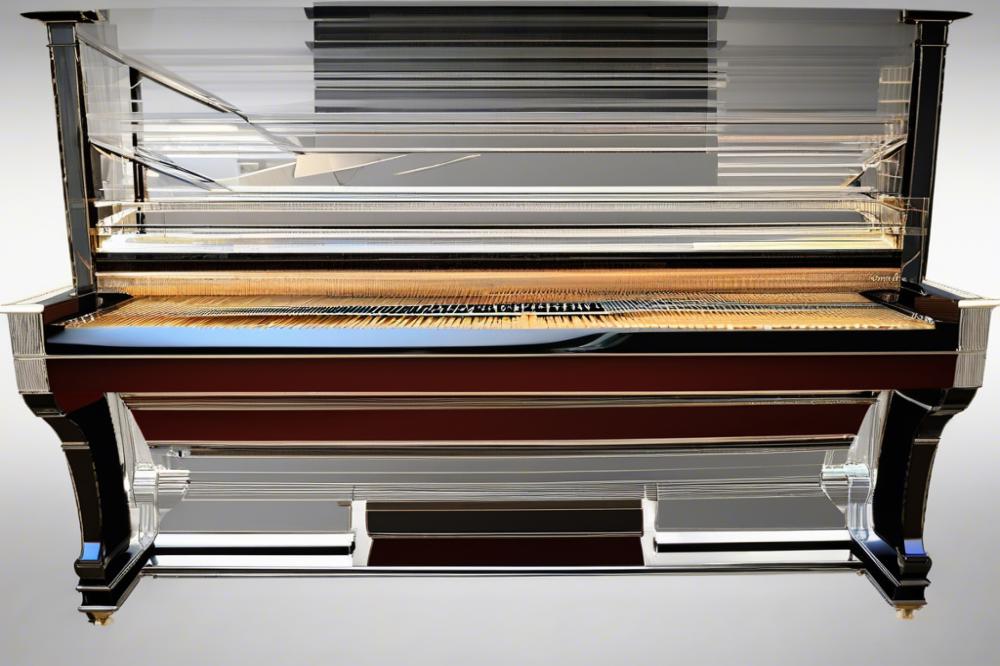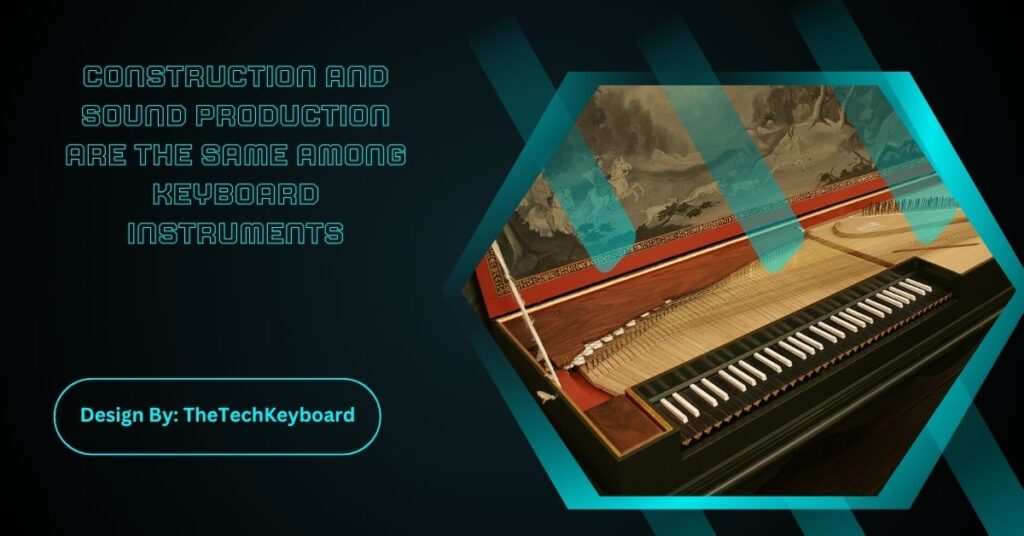Keyboard instruments may look similar, but they differ greatly in construction and sound production. Acoustic, digital, and electronic keyboards use distinct methods and technologies to produce their unique sounds and performance styles.
When it comes to keyboard instruments, many people believe they all share the same construction and sound production. While they may look similar—rows of black and white keys—the truth is far more complex. Keyboard instruments, including pianos, organs, synthesizers, and digital keyboards, differ significantly in how they’re built and how they produce sound.
In this article, we’ll break down the construction and sound mechanisms of various keyboard instruments, compare them, and explore how these differences affect sound quality, playability, and usage.
Understanding Keyboard Instruments: A Broad Category
The term “keyboard instrument” covers a wide range of devices that are played using a keyboard. Common types include:
- Acoustic Piano
- Digital Piano
- Synthesizer
- Organ (Pipe, Electric, or Digital)
- Clavichord and Harpsichord
- MIDI Controller Keyboards
Despite their similar interface—a keyboard with keys—the construction and sound production in each is unique.
Acoustic Piano: Mechanical Construction and String-Based Sound

The acoustic piano is one of the most iconic keyboard instruments. It produces sound mechanically, using:
- Hammers that strike strings when a key is pressed.
- Soundboard that amplifies the string vibrations.
- Pedals to sustain or soften notes.
The physical construction involves wood, metal strings, felt hammers, and a large resonating body. Its sound is rich, dynamic, and varies based on the touch of the player.
Sound Production: Mechanical and acoustic—no electricity required. The harder you press, the louder the sound.
Digital Pianos: Simulated Sound with Weighted Action
Digital pianos aim to replicate acoustic pianos electronically. They use:
- Samples of real pianos recorded at different velocities.
- Weighted or semi-weighted keys to simulate hammer action.
- Built-in speakers or headphone jacks for output.
Construction-wise, they’re compact and lighter than acoustic pianos but prioritize realistic key feel and sound quality.
Sound Production: Digital samples triggered by key presses; no strings or hammers involved.
Synthesizers: Electronic Sound Design Tools
Synthesizers are designed to create and shape electronic sounds. Instead of replicating acoustic instruments, they offer:
- Oscillators to generate waveforms.
- Filters and envelopes to modify sound.
- LFOs for vibrato, tremolo, and more.
Synths can be analog, digital, or hybrid and come with various construction styles—modular, semi-weighted keys, or even desktop-only units.
Sound Production: Purely electronic, controlled by voltage or digital signal processing.
Organs: Air, Electricity, and Digital Sound
Organs vary greatly in how they work:
- Pipe Organs: Use air passing through pipes, each key triggering a valve.
- Electric Organs: Use tonewheels or circuits to generate sound (e.g., Hammond B3).
- Digital Organs: Emulate the pipe or electric organs using samples.
Their construction involves multiple keyboards (manuals), foot pedals, and sometimes large wooden cabinets.
Sound Production: Air flow (pipe organs), electromechanical tone generation (electric organs), or digital samples (modern organs).
Harpsichords and Clavichords: Historical Keyboard Instruments
Long before pianos, the harpsichord and clavichord were popular.
- Harpsichord: When a key is pressed, a quill plucks the string, giving it a bright, metallic sound.
- Clavichord: Uses tangents to strike strings, producing softer sounds with limited dynamics.
Their construction is simpler than modern pianos but mechanically intricate and historically significant.
Sound Production: Plucked or struck strings—no dynamic control like a piano.
MIDI Keyboards: No Sound, Just Control
MIDI controller keyboards don’t produce sound on their own. They are used to control software instruments on computers or digital audio workstations (DAWs).
- They send MIDI signals (digital messages) to external devices.
- Often used in music production, composing, and live performances.
Sound Production: None directly; depends on connected software or hardware instruments.
Key Differences in Sound Production
Let’s summarize how sound is produced across these instruments:
| Instrument | Sound Source | Action Type | Electricity Needed |
| Acoustic Piano | Strings + Hammers | Mechanical | No |
| Digital Piano | Sample Playback | Weighted Digital | Yes |
| Synthesizer | Oscillators + DSP | Electronic | Yes |
| Pipe Organ | Air through Pipes | Pneumatic | No |
| Electric Organ | Tonewheels/Circuits | Electromechanical | Yes |
| Harpsichord | Plucked Strings | Mechanical | No |
| Clavichord | Tangents Strike Strings | Mechanical | No |
| MIDI Controller | Sends MIDI to Others | Digital | Yes |
Are They the Same in Construction and Sound?

Short Answer: No, they are not.
While keyboard instruments share the same interface (keys), their internal mechanisms, materials, and methods of sound production vary significantly.
- Acoustic instruments rely on physical components like strings, hammers, or air.
- Digital and electronic instruments use samples or synthesized waveforms.
- Some are standalone sound producers, others are just controllers.
This variation leads to diverse sound characteristics, maintenance needs, and usage scenarios.
Why This Matters for Musicians and Producers?
Understanding these differences is essential when choosing a keyboard instrument for:
- Learning piano technique
- Performing live music
- Creating electronic sounds
- Recording or composing music
- Experimenting with historical or classical sounds
Choosing the right tool enhances your music creation and expression.
FAQs:
1. Are all keyboard instruments built the same way?
No, keyboard instruments differ in construction. Acoustic pianos use strings and hammers, while synthesizers use electronic circuits. Each type has a different internal mechanism tailored to its sound production method.
2. How do acoustic and digital pianos differ in sound production?
Acoustic pianos produce sound mechanically through hammers and strings, while digital pianos replicate this using pre-recorded samples triggered by keys. The feel might be similar, but the internal mechanics are entirely different.
3. Do synthesizers produce natural piano sounds?
Synthesizers don’t produce natural piano sounds unless loaded with specific samples. Their primary function is sound design through waveforms, filters, and modulation—not acoustic emulation like digital pianos.
4. Can MIDI keyboards create sound without a computer?
No, MIDI keyboards send signals to other devices and don’t produce sound themselves. They must be connected to a sound module, computer, or synthesizer software to function audibly.
5. Why is it important to understand these differences when buying a keyboard?
Understanding construction and sound production helps match a keyboard to your needs—whether for classical performance, music production, or portability. The right choice improves learning, creativity, and overall user satisfaction.
Conclusion:
While keyboard instruments may share a similar layout, their construction and sound production methods vary widely. From acoustic pianos that use strings and hammers to synthesizers that rely on electronic waveforms, each type serves a unique purpose. Whether you’re a beginner, performer, or producer, knowing these differences helps in choosing the right instrument for your needs. Understanding the mechanics and sound capabilities ensures better performance, targeted practice, and greater enjoyment in both live settings and studio environments.
Related Post:
- Reid Russom – Purpose-Driven Educator and Leader!
- Numa Zara – Digital Fashion Revolution Blending Identity!
- Ecryptobit – Buy, Sell & Secure Digital Assets!
- Long Shooter – From Idioms and Film!
- Kick Flipper – Best Indoor Practice Board!
- Shannon Reardon Swanick – Leader Who Inspires Change!
- Serumcu – Eco-Friendly Cleaner for Stains and Odors!
- Nucleuscoop Keyboard Not Working – Causes, Fixes & User Guide!


